Carnival in French Guiana 2026
The 2026 French Guiana Carnival: an unforgettable experience awaits
In French Guiana, Carnival is one of the longest in the world. It begins on Epiphany (early January) and ends on Ash Wednesday, meaning around two months of festivities!
Carnival lasts throughout the season, with:
Masquerade balls on Saturday evenings,
Street parades (called "vidés") every Sunday,
The touloulous, iconic figures of the carnival, who only appear at the balls,
And an intensification of the celebrations from Fat Friday to Ash Wednesday.
🎭 In 2026, the French Guiana Carnival, which will run from January 11 to February 18, 2026, promises to be even more spectacular!
Below is the complete calendar for the 2026 French Guiana Carnival. Open your calendar, note the dates and days of Carnival 2026 so you don't miss out on this immersion in French Guiana culture!
Les jours gras
Dimanche gras : 📅 : 15 février 2026
Lundi gras :📅 : 16 février 2026
Mardi gras : 📅 : 17 février 2026
Mercredi des cendres : 📅 : 18 février 2026
Dates and program for the 2026 French Guiana Carnival
Find the full official program on our special page dedicated to the dates of the French Guiana Carnival 🎭. Stay tuned so you don't miss out on one of the most spectacular and authentic carnivals around
Sunday, January 11, 2026, will mark the official launch of the street carnival in Cayenne, with the first weekly parades and videos. The parades will continue in the following weeks across the island of Cayenne, Rémire-Montjoly, and Matoury, before taking over Kourou on February 8 for the grand parade. Sunday, February 15, Shrove Sunday, will be the highlight of the carnival: morning parties in Cayenne and Saint-Laurent-du-Maroni, followed by a grand closing parade bringing together all the carnival groups in an explosion of music, costumes, and colors. The nighttime festivities will begin on Saturday, January 10, 2026, with the first masked ball, marking the arrival of King Vaval and the return of the Touloulous, the masked ladies who reign over the dance floors. Every weekend, legendary orchestras—Les Mécènes, Les Blue Stars, Ti Coco ké lé Blada—will thrill the crowds with mazurkas, biguines, and piké djouk. The last Touloulou ball will take place on Saturday, February 14, 2026, before Mardi Gras. At the end of the season, it's time for the Tololos ball: the roles are reversed and it's the men who wear masks to invite the women to dance. This "Face-à-face des Tololos," held on Friday, February 13, 2026, brings a touch of humor and freedom before the final celebrations..
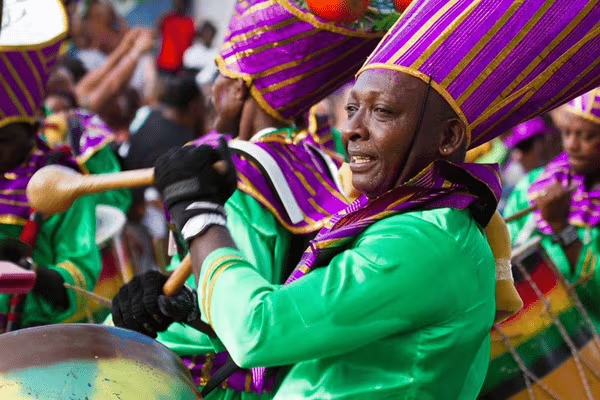
Grand parade in Kourou @credit Alexandre RUTECKI
Origins and evolution of the Carnival of French Guiana
The French Guiana Carnival is one of the major cultural events in French Guiana, notable for its exceptional length, lasting from Epiphany to Ash Wednesday, and for its ability to bring together all the Caribbean, Amerindian, Asian, and European communities.
The origins of the carnival date back to Christian traditions imported by colonists, marking the period of festivities before Lent. Born in the 17th century during the colonial period, it was initially reserved for European colonists. Gradually, freed slaves appropriated this celebration to express their creativity, resistance, and renewed joy after the harvests.
A celebration of memory, culture, and identity
Today, the French Guiana Carnival is much more than just a celebration: it is a showcase for French Guiana's cultural heritage, bringing together traditions, music, and colorful costumes. In Cayenne, Kourou, and Saint-Laurent-du-Maroni, each parade tells a piece of history and reminds us that French Guiana remains a land of diversity and creativity.
🎭 Iconic characters of the French Guiana Carnival
All the characters bring to life a deeply Creole and multicultural celebration, blending history, memory, satire, and popular joy. A true living heritage, the French Guiana carnival attracts thousands of visitors every year who come to admire the cultural richness of this unique territory.
Quel est le principal personnage du carnaval en Guyane ?
The Touloulou is undoubtedly the queen of the French Guiana Carnival. Entirely covered in gloves, a petticoat, an elegant dress, and a mask, she embodies mystery and elegance. Only the Touloulou has the right to invite a man to dance at masked balls, symbolizing female freedom and the reversal of social roles.
What is the traditional costume for the carnival in French Guiana?
There are many characters that bring the carnival scenes of French Guiana to life, each with their own symbolism and history. Among them are Vaval, the king burned on Ash Wednesday, the Red Devils embodying disorder, the Zombis Baréyo, the soot-covered Bobi, the Nèg Marrons symbols of freedom, the mischievous Dja dan Bwet, the dirty Touloulous, the Videngeurs, AngleBannan, and Bèf volé Bèf.
But the Carnival of French Guiana would not be complete without other mythical figures:
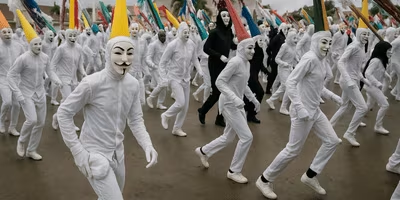
Jé Farin
Dressed entirely in white and wearing masks, they symbolize purity and anonymity. They wander around throwing flour, in an atmosphere that is both joyful and mystical.
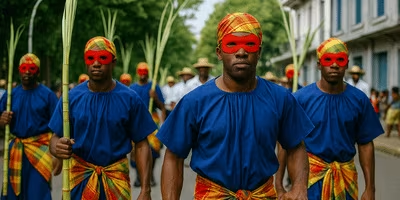
Cane cutters
A figure representing agricultural workers, he pays tribute to former slaves and plantation workers. His machete and gestures evoke strength and memory. Dress code: navy blue and a madras fabric "kanm'za."
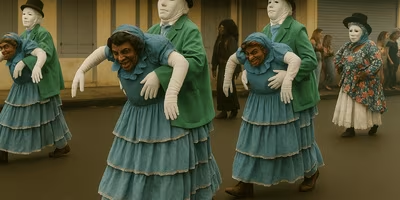
Karolin
A burlesque duo consisting of a woman carrying her husband on her back. According to her, "good husbands are rare, so I carry mine on my back so that no one takes him away from me." La Karolin shows off her wealth with her dress and gold.
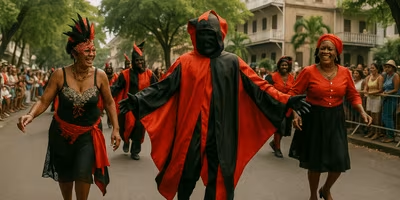
Sousouris
Masked and dressed in black, they mimic the bats that invade the night. Their rapid movements evoke discretion and mystery. They usually flank the red devils.

"Touloulous"
Queen of Carnival, masked and gloved, she embodies mystery, grace, and female empowerment. Only the Touloulous invite men to dance. Head to the fancy dress balls to see their famous "piké djouk" dance step.
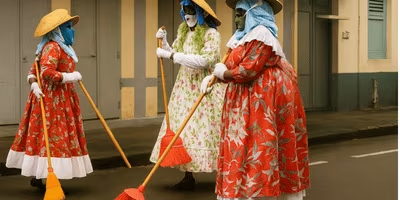
Sweepers
Armed with brooms, they symbolically clean the streets before the groups pass by. They embody purification and renewal. They enjoy sweeping the feet of spectators.
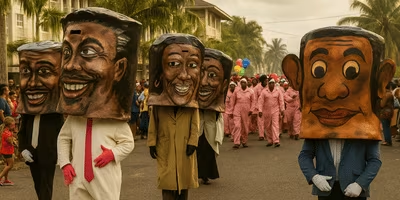
"Gro Tèt"
Recognizable by his disproportionate head, he symbolizes mockery and excess. He entertains the crowd by parodying the powerful and the vain.
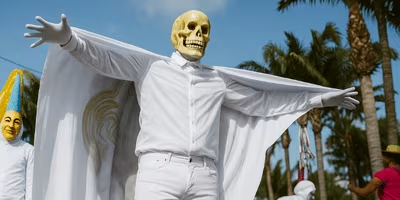
Lanmo
"Lanmo volo lanmo," which means "death steals death." A figure of death dressed in black and white, she reminds us of the inevitable end of Carnival. She parades slowly, carrying a scythe or skeleton.
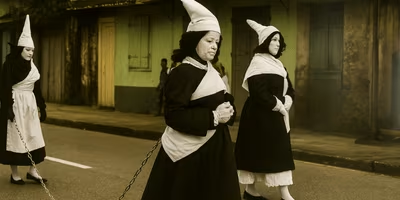
The Djabless
The Djabless appears on Ash Wednesday, the day of mourning for King Vaval. Dressed in black and white, she parades through the streets one last time, symbolizing sadness. She marks the end of the French Guiana Carnival.
💡 Europcar's tips for an unforgettable experience in French Guiana
The French Guiana Carnival is a unique event when the streets of Cayenne, Kourou, and Saint-Laurent light up with music, dancing, and colorful costumes.
Respect traditions and costumes: Each character, from the Touloulou to the Karolin, has its own symbolism. Observe and take photographs, but without disturbing the carnival participants.
Think about your comfort: Bring water, a hat, sunscreen, and light clothing. The tropical climate and the energy of the carnival can quickly wear you out!
Capture the moment: The colorful streets, lively music, and smiles of the participants offer unforgettable memories.
Choose local transportation: Park your vehicle near secure areas and continue on foot to enjoy the atmosphere of the street parties and masked balls.
Plan your trips in advance: Roads can be very busy during parades and carnival season. Rent your car in advance at our Cayenne Collery or Félix Eboué Airport branches to travel freely between carnival towns.
🚗Book your vehicle now
To make sure you don't miss a thing, rent a car from Europcar French Guiana and follow the parades through the towns in complete freedom.

Subscribe to our newsletter
Subscribe to our newsletter and receive our best offers of the moment exclusively


Tripadvisor

Travel award

Kayak
@Europcar French Guiana





